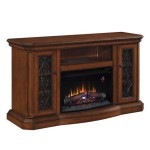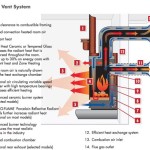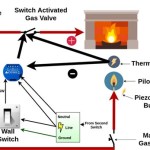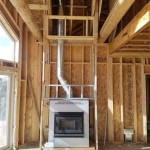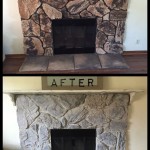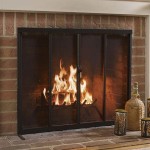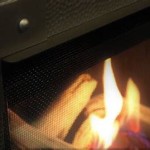Understanding Gas Glass Fireplaces: Aesthetics, Efficiency, and Safety
Gas glass fireplaces offer a modern and visually appealing heating solution for homes and businesses. These fireplaces combine the convenience and efficiency of gas fuel with the sleek aesthetic of a glass enclosure, providing a controlled and attractive flame presentation. The following sections will explore the key aspects of gas glass fireplaces, including their functionality, benefits, installation considerations, safety features, and maintenance requirements.
The core function of a gas glass fireplace is to generate heat through the combustion of natural gas or propane. A burner system meticulously engineered to distribute the gas evenly creates a consistent and visually appealing flame pattern. The glass enclosure serves multiple purposes: it provides a safety barrier, protects the flame from drafts, and radiates heat into the surrounding space. The enclosed design contributes to greater energy efficiency compared to traditional open fireplaces, as it minimizes heat loss up the chimney.
Efficiency and Heat Output
One of the primary advantages of gas glass fireplaces is their efficiency. Unlike wood-burning fireplaces, which can lose a significant portion of their heat through the chimney, gas glass fireplaces are designed to retain and radiate heat effectively. This efficiency stems from the sealed glass front and the controlled combustion process. The glass acts as a radiant heat source, distributing warmth directly into the room. Furthermore, many models incorporate venting systems designed to maximize heat transfer. These vents can be coaxial (venting both intake and exhaust through a single pipe) or direct vent (venting exhaust directly outside). The choice of venting system significantly impacts the fireplace's overall efficiency and installation requirements. Higher efficiency ratings translate to lower fuel consumption and reduced heating costs over time.
The heat output of a gas glass fireplace is typically measured in British Thermal Units (BTUs). The BTU rating indicates the amount of heat the fireplace can generate per hour. Fireplaces are available in a wide range of BTU outputs, allowing homeowners to select a model that meets the specific heating needs of their space. Factors such as room size, insulation levels, and climate conditions should be considered when determining the appropriate BTU rating. Smaller rooms may only require a low-BTU fireplace, while larger spaces will benefit from a higher-output unit. It's also important to note that some models feature adjustable flame settings, allowing users to control both the heat output and the visual appearance of the flame.
Beyond the immediate heat output, the efficiency of a gas glass fireplace also contributes to a more consistent and comfortable room temperature. The controlled combustion and radiant heat distribution prevent the temperature fluctuations often associated with wood-burning fireplaces. This consistent heat ensures a more comfortable and energy-efficient heating solution.
Aesthetic Versatility and Design Options
Gas glass fireplaces offer a wide range of aesthetic options, allowing homeowners to seamlessly integrate them into various interior design styles. The glass enclosure itself presents a clean and modern look. The design possibilities extend beyond the glass, encompassing a variety of features such as log sets, decorative fire glass, and surround materials. Log sets, often crafted from ceramic or refractory materials, are designed to mimic the appearance of natural wood, providing a traditional fireplace aesthetic. Decorative fire glass, available in a multitude of colors and textures, allows for a more contemporary and personalized flame presentation. The surround, which frames the fireplace, can be constructed from materials such as stone, marble, tile, or wood, further complementing the overall design. The flexibility in design allows homeowners to create a focal point that reflects their individual style preferences.
The installation options for gas glass fireplaces also contribute to their design versatility. These fireplaces can be installed in a variety of locations, including walls, corners, and even as freestanding units. Wall-mounted fireplaces offer a space-saving solution, while corner units can maximize the use of limited space. Freestanding models provide a more traditional fireplace appearance and can be easily relocated if needed. The ability to install a gas glass fireplace in various locations provides greater flexibility in interior design planning.
Furthermore, many gas glass fireplaces are equipped with remote controls, allowing users to adjust the flame height, temperature, and even the lighting features. This enhanced control contributes to both the aesthetic appeal and the functional convenience of the fireplace. The ability to customize the flame appearance and heat output allows homeowners to create the desired ambiance for any occasion.
Safety Features and Operational Considerations
Safety is a paramount concern with any heating appliance, and gas glass fireplaces incorporate numerous safety features to minimize risks. The glass enclosure itself serves as a crucial safety barrier, preventing accidental contact with the flame. The glass is typically made from tempered or ceramic materials, designed to withstand high temperatures and resist shattering. Many models also include safety screens or grates that further protect against accidental burns.
Gas leak detection systems are a standard safety feature in modern gas glass fireplaces. These systems continuously monitor for gas leaks and automatically shut off the gas supply if a leak is detected. This prevents the accumulation of flammable gas and reduces the risk of explosions. Furthermore, many fireplaces are equipped with oxygen depletion sensors (ODS), which monitor the oxygen levels in the room. If oxygen levels drop below a safe threshold, the ODS will shut off the gas supply to prevent carbon monoxide poisoning.
Proper ventilation is essential for the safe operation of a gas glass fireplace. As mentioned earlier, these fireplaces utilize either coaxial or direct vent systems to exhaust combustion gases outside the home. These venting systems prevent the buildup of carbon monoxide and other harmful pollutants indoors. Regular inspection and maintenance of the venting system are crucial to ensure its proper functioning. Professional installation by a qualified technician is highly recommended to ensure that the fireplace is properly connected to the gas supply and venting system.
Operational considerations also include proper maintenance and cleaning. The glass enclosure should be cleaned regularly to remove soot and debris, ensuring optimal visibility of the flame. The burner system should also be inspected periodically to ensure proper gas flow and combustion. It is recommended to schedule a professional inspection and maintenance service at least once a year to ensure the safe and efficient operation of the fireplace. This service should include cleaning the burner system, inspecting the venting system, and checking for any gas leaks.
The pilot light is another operational consideration. Some gas glass fireplaces have a continuous pilot light, while others use an electronic ignition system. A continuous pilot light consumes a small amount of gas even when the fireplace is not in use. Electronic ignition systems eliminate the need for a pilot light, saving energy and reducing gas consumption. The choice between a continuous pilot light and electronic ignition depends on individual preferences and energy-saving priorities.
In addition to these safety and operational considerations, it's also important to be aware of local building codes and regulations regarding the installation and use of gas fireplaces. These codes may specify requirements for venting, gas line installation, and fire safety. Consulting with a qualified contractor or building inspector can ensure compliance with all applicable regulations.
Finally, educating all household members about the safe operation of the gas glass fireplace is crucial. This includes understanding how to operate the controls, recognizing potential hazards, and knowing what to do in case of a gas leak or other emergency. By following these safety precautions and operational guidelines, homeowners can enjoy the warmth and ambiance of a gas glass fireplace with peace of mind.

Studio Glass Gas Fires Gazco Built In Contemporary Fireplaces

Studio Glass Gas Fires Gazco Built In Contemporary Fireplaces

Bhd4pgn Napoleon Fireplaces Ascent Peninsula With Glass Bed Natural Gas Fireplace Big George S Home Appliance Mart

We Will Be Updating Our Fireplace To Use Glass Rocks Rather Than Logs Outdoor Gas Firepit That Fire
Gazco Studio Edge Gas Fire Hot Co

Fireplace Installation Instructions Diamond Fire Glass

Building Modern Gas Fireplace By Element4 Trisore 140 Three Sided Glass 102729b Arcat

Superior Drl2035 35 Inch Electronic Ignition Direct Vent Gas Fireplace With Crushed Glass Media

Superior Drc2033 33 Inch Electronic Ignition Direct Vent Gas Fireplace With Crushed Glass Media

Is Your Gas Fireplace Safe Fireside Home Solutions
Related Posts

